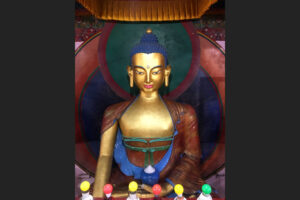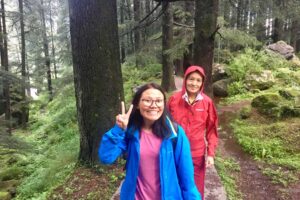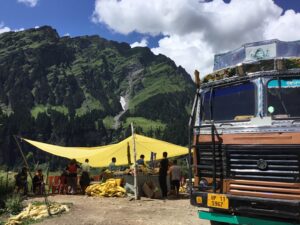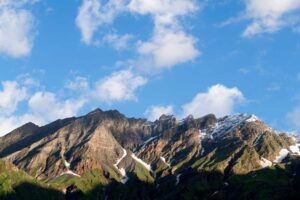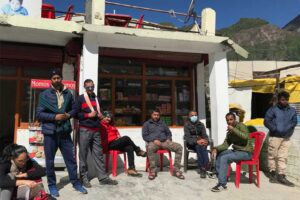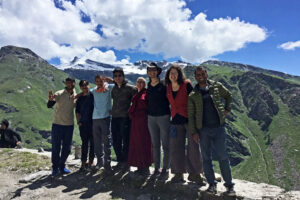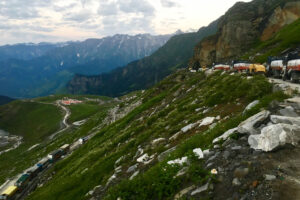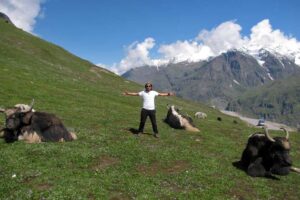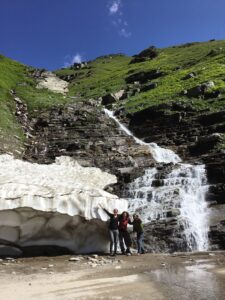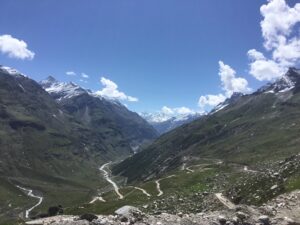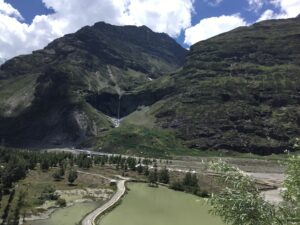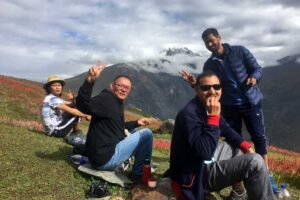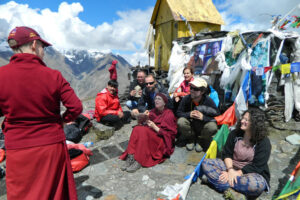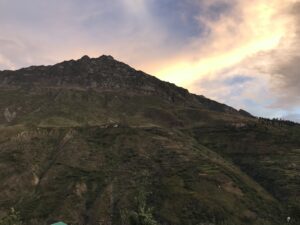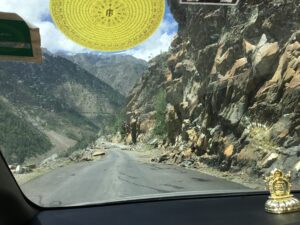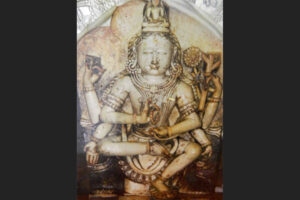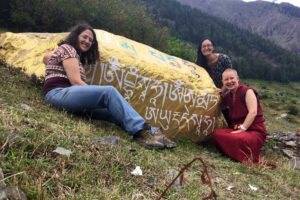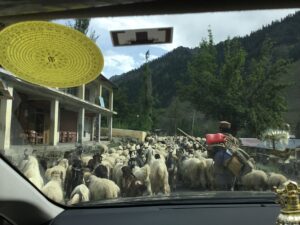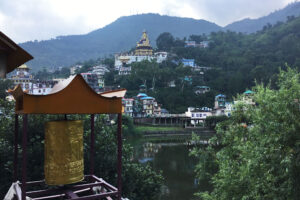- Home
- About Us
- Programs
- Being Here
- FAQs
- Resources
- News
- Links
- Support Us
Nov

Tushita Goes on Pilgrimage!
This year in August, the staff of Tushita did something remarkable following Lama Zopa Rinpoche’s advice; we closed our doors for a week and, together, went on pilgrimage! Our destination was Garsha, the Land of Dakinis: Lahaul in northern Himachal Pradesh. This spiritual adventure was filled with both trying and recurring obstacles, threatening safety and causing some to turn back, and for those who endured…powerful blessings!
But first let us shortly look back, how this pilgrimage came about:
In 2013 we had been blessed to be invited by Lama Zopa Rinpoche to visit Lahaul, where Rinpoche did a private retreat in Phakpa (Triloknath) together with Serkong Tsenshab Rinpoche and Khadrola.
And in 2015 the Tushita team had followed Rinpoche’s advise to go on pilgrimage for the first time.
Our primary destinations:
- Drilbu Ri – Chakrasamvara Mountain – Palace of the Buddha’s Enlightened Body
- Phakpa (Triloknath) – Avalokiteshvara Statue & Milky Lake (Omay Tso) – Palace of the Buddha’s Enlightened Speech
- Markula (Udaipur) – Vajravahari Temple – Palace of the Buddha’s Enlightened Mind
On the way:
- Sangam – Meeting of Chandra & Bhaga Rivers to unite as Chandrabhaga River
- Tara Temple & Palden Lhamo Waterfall near Sissu
- Padmasambava Caves & Statue in Rewalsar (Tso Pema)
Through the Bardos
At 10pm on August 18th, nineteen of Tushita’s staff and volunteers loaded up into a bus and two additional vehicles to begin our long, overnight drive to our first waypoint: Manali. Ginger tablets and dramamine were washed down with efforts of strategic timing and prayers for effectiveness by those susceptible to the destabilizing effect of the twists and turns the road ahead promised. The hours of winding roads lived up to their reputation as a few meals reversed course, never completing their digestion, and others barely held on.
In the early, still-dark hours of the next morning, just outside of Manali, we came to a halt as we were faced with the two lane road which had crumbled to less than one, washed away by the heavy rains into the river below. Vinod, Tushita’s trusted driver who manned one of the vehicles, assessed the situation – uncertain if we could make it across. With a nagging feeling telling him no, he reluctantly backed off, allowing the car that had come up behind us to make their choice. As this new vehicle asserted its confidence in forging ahead, we all felt a wave of both relief and empathy as the car became stuck precisely where Vinod had a bad feeling.
Reversing and attempting two hour-long detours before finally finding an alternate way through, all three cars reconvened in the light of a new day in Manali.
Before we could continue our ascent, we were required to obtain permits to go through Rohtang Pass, a high mountain pass (3,978m/13,050ft) connecting the mostly Hindu Kullu Valley below with the predominantly Buddhist Lahaul and Spiti high-altitude valleys above. With a history of dangerous conditions, Rohtang Pass literally translates to “corpse field”. Fortunately, most of the pilgrims were ignorant to that specific charming detail, and when our permit was denied that day due to landslides, we happily embraced a day to explore Manali.
Unaware at the time of planning, His Holiness the Dalai Lama had given a few days of public teachings in Manali until the day before our arrival there. His Holiness still stayed nearby our hotel and we passed His residence many times hoping for a glimpse and praying for blessing for our upcoming endeavor.
With a good night’s sleep in comfortable hotel beds, breakfast in our bellies, and permits in hand, we piled back into the cars on the 20th to continue towards Rohtang Pass and beyond. Now, we were moving! Up and up, we climbed, the air getting cleaner and thinner, the mountains surrounding us becoming more majestic. With each turn of the road the views became more spectacular. Waterfalls decorated the green, soaring mountains covered in a multitude of wildflowers.
We turned a corner at 3,000m (10,000ft) and hit the breaks. A long line of vehicles rested. Close inspection revealed that our predecessors had already been here for quite some time, stopped by a landslide far ahead. Our progress was halted!
Camping on the alpine mountainside was not on the itinerary, yet I think we all embraced it as a marvelous gift. The sun shone (particularly precious after the monsoon we left behind), the view – again- was spectacular, and some astute entrepreneurs threw up tents and started selling chai, instant noodles and omelets for the stranded, hungry masses. All our needs were met!
As the sweetness of the day began to fade with the setting sun and the chai shops disappeared just as they had miraculous appeared earlier, engines started and wheels began to roll. We were off again!
We climbed another 1,000 ft and passed through a dhaba shanty town called Marhi. Its dhabas promised warm dinner with an indulgent array of options that extended beyond two items, but no, we were going to push on! Cover ground! Get. Through. That. Pass!
Onward we went, now in the darkness. Climbing, climbing, following the train of cars. As we were busy calculating what time we would now arrive at our next waypoint, we came to a temporary stop… which gradually revealed itself to be temporary of the longer nature. Just as quickly as the wind of movement had filled our sails, it dropped out and we were again sitting, totally still on the mountainside. Another landslide.
Somewhat crestfallen, we surveyed the situation and decided to head back down the hill to Marhi where we could enjoy a late dinner and hopefully find some rooms to rent. The food renewed our spirits and bellies and helped the news of no rooms available land a little softer. We all spent a night in a variety of contortions, with varying temperature regulation success in our respective vehicles. Those on the bus surely purified the most karma that night.
The morning of the 21st we reverse Tetris-ed ourselves out of our vehicles to see the snow-topped mountains that held us in their midst. At 3,360m (11,020ft), we were fortunate for this extra time to acclimate our bodies to the lower oxygen levels, and some of us capitalized on this by hiking around to see more of the beautiful scenery and stimulate red blood cell production.
When the unmoving line of cars on the mountainside above finally began to move just before lunchtime, we jumped into the cars and sped up the hill to join the queue. We passed the point we had stopped at the night before, and felt the satisfaction of gaining ground before turning the bend and finding ourselves stopped once again. The culprit? You guessed it. Another landslide.
We found ourselves in a bardo state, having left but not yet having arrived. Just as we were in an in-between we realised the mountain itself was in its own bardo state – transitioning, changing, becoming something new… no longer the mountain it was, but not yet settled into the mountain it would become. We had no option but to honor the mountain’s process and use the time to honor our own.
Making the most of our bardo experience, we spent another day perched on the mountainside, sharing snacks, and soaking up the expansive views and warm rays of the sun. This time we weren’t far behind the slide. As the road looped back on the mountain above us we could see where the disruption had occurred – an enormous boulder obstructed the road.
Eventually we heard the startling boom of dynamite and some time later, began to see the trucks that had been halted on their way down resume their journey through a one-lane pass that had been created. For well-over an hour these trucks rumbled past us in a seemingly unending stream as we awaited our turn with varying appearances of patience.
At some point, the unseen decision-maker deemed it was time to switch directions and allow those of us going up the mountain to have a turn. We were ecstatic! Engines started, gears were engaged, we rolled forward the length of five cars before stopping again. What’s going on? Why aren’t we moving anymore? Say it with me now: landslide.
This continued in stops and starts until we made our way just behind the thwarting segment of road as darkness took hold. All movement halted. It was too dangerous to proceed. We would not get through that night. The promise of a real bed and warm meal dissolved as we realised we had no option but to sleep – once again – in our vehicles. Turning back to Marhi was not an option either.
It was at this point that a few stalwart pilgrims felt they could not continue. Four took their bags and headed back down the mountain on foot to catch buses back to Manali and then home. Other brave (and fit) members hiked down to Marhi, loaded up on fresh paranthas, and selflessly hiked back up the mountain in the darkness. Dinner arrived near midnight to our exhausted and hungry group trying to find a more comfortable arrangement of body parts for another night of car sleeping.
With the dawn came the tractor operators and renewed energy. Before too long, hardly trusting the reality of it, we drove through the troublesome tract and made our way finally up to Rohtang Pass on August 22nd.
After stopping to share our epic triumph with the local yaks and enjoying some snow, we went down down down the winding road into Lahaul.
Following the Chandra river, near the village of Sissu we could see on the opposite side of the river the impressive Palden Lhamo waterfall, which is said to be a self-arisen manifestation of the Dharma Protectress.
Not long after, another grand view greeted us: the two rivers of Chandra and Bhagra becoming one, the Chandrabhaga (Chenab) River, forming thus a natural triangle. Looking at a wider picture the rivers Chandra and Bhagra first branch from the two sides of the Baralacha pass, then flow into opposite directions describing a circle to finally meet here again. This confluence is regarded a holy place for Buddhists and Hindus alike.
We were now standing right at the foot of Drilbu Ri, or Heruka Mountain, our first pilgrimage destination. But before starting the climb the next morning, we were yearning to spend the night not in our car or bus, but in a real bed again! Finding a hotel in Keylong, a small administrative town at the base of the mountain, we collapsed on our beds, delighted in the sweetness of bathing, and rediscovered the alternate clothing items we vaguely remembered packing days earlier.
Drilbu Ri – The Palace of the Buddha’s Enlightened Body
Early on August 23rd, we headed to the sacred Drilbu Ri, the Mountain of Spontaneous Union, associated with Chakrasamvara. Traditionally said to be “the palace of the Buddha’s enlightened Body”1, many realised practitioners came here to meditate and receive its powerful blessings. These practitioners include the great master Nagarjuna, the legendary Mahasiddha Ghantapa, and many others.2
Starting near Kardang Gompa, we passed through fields of medicinal pink and red flowers as we climbed ever higher in the thin air, working our way with much effort toward the peak.
Under the cover of the misty morning, the 15 of us (along with a group of Spanish pilgrims led by our former co-director Kiko) began our slow but steady circumambulation (or kora) of the sacred mountain, basking in its purifying and wish-fulfilling vibrations. We passed through fields of medicinal pink and red flowers as we climbed ever higher in the thin air, working our way with much effort toward the peak. One could easily imagine the times when villagers would regularly tell of hearing “music emanating miraculously from the mountainside, as if divine beings were engaging in sacred rituals”.3
After five hours we reached the summit at 4,420 m (14,500 ft), exhausted and happy, following in the footsteps of many great, modern masters such as His Holiness the Dalai Lama, Sakya Trinzin, and the Gyalwang Drukpa. We offered incense, prayer flags, and prayers from our heart, said to definitely be fulfilled in such a powerful place as this.
We completed our kora with the inevitable descent, testing the vitality of our knees while feeling deeply satisfied. One could almost imagine the sky around us filled with dakinis offering their blessings. We felt that deep purification had surely taken place in making pilgrimage and kora in such a holy mountain, described by His Holiness the Gyalwang Drukpa as having three times the merit as a kora of Mount Kailash!4
A good night’s sleep in Keylong helped restore our bodies after climbing the equivalent of 255 flights of stairs. Refreshed, we were ready to continue to our next destination: Phakpa, the Unequalled Abode of Compassion, in Triloknath.
However, first we had to overcome a few more obstacles – due to the landslides there was no gasoline for our vehicles available and the only public bus was hopelessly full to the rim. But as we know, the more hardships on a pilgrimage the more merit! Somehow, we overcame the challenges of the morning and could finally continue on.
Phakpa – The Palace of the Buddha’s Enlightened Speech
Triloknath is a tiny village in the Chandrabhaga valley. Low-ceiling-ed, archaic structures full of character line the two brief paths that make up the town. One easily feels transported to another century; the relatively large building in the center – the former residence of the local king – is said by locals to be 1000 years old. The original settlement of this location is thought to be founded by Nagarjuna himself with archaeological evidence suggesting the flourishing of Buddhism here from the 2nd century.5
The Phakpa temple, dedicated to Chenrezig and toward which we now headed, was built in the late 9th or early 10th century after the miraculous appearance of a white marble statute of Chenrezig with Amitabha Buddha at his crown.
Lama Zopa Rinpoche explained the importance of Phakpa and this Chenrezig statue to Ven. Sarah Thresher and others here. She recalls:
“Legend tells of a shepherd who came to the valley from Tibet. (Rinpoche says the shepherd was a holy being and Khandrola thinks he may have been an emanation of Tara). The shepherd would take the village goats up to a small lake in the mountains to graze but when the goats came back down to the village they had no milk. The village people began to suspect that the shepherd was taking the milk for himself, but this was not true, and the shepherd decided that the next time he went up the hill he would hide and watch to see what happened. What he saw was that Chenrezig would emerge from the lake and drink the goats’ milk.
“The shepherd approached Chenrezig and explained that he was being accused of taking the goats’ milk. He requested Chenrezig to please come down with him and tell the local people it was not true. Chenrezig agreed and told the shepherd to carry him on his back down to the village. Chenrezig said to the shepherd, “You may hear a noise as we are leaving but whatever happens don’t look back!” Sure enough, as they descended, the shepherd heard a loud sound but, ignoring Chenrezig’s advice, he looked behind and saw seven white men following. When these seven beings saw the shepherd they turned back and transformed into seven nagas or snakes that eventually merged into the hillside. (Rinpoche says that if the shepherd had not turned back these could have been more deities and there would have been more holy objects to liberate sentient beings but due to our karma that didn’t happen.)
“As the shepherd continued walking, Chenrezig became heavier and heavier, and by the time they reached the village, where there was a lot of conflict and fighting, Chenrezig became too heavy to carry. The shepherd then dropped Chenrezig who transformed into pure white marble. For this reason, it is said the statue is actually Chenrezig who has taken the form of a statue for us sentient beings. The shepherd also absorbed to a stone and both images, along with a black stone representation of Four-armed Mahakala with a naturally arising OM MANI PADME HUNG inscription at the back are housed in the small temple.
“Several miracles have been reported in connection with the Phakpa over the years, including the statue speaking and dripping with nectar. These days, a kind and gentle old Gelukpa monk takes care of the temple and pilgrims. He was appointed by His Holiness the Dalai Lama and has been there for sixteen years. Rinpoche hopes that in the future more monks will settle and a small monastery will develop, the monks engaging in study and practice—particularly lam-rim—as well as performing pujas for the local people and pilgrims.
“Tibetans and Buddhists from the Himalayan regions come to Triloknath to pray and also to do Nyung-ne, Chenrezig fasting retreat. Rinpoche encouraged us to practice and dedicate as much as possible at the temple, explaining that all the prayers made to the Phakpa and shepherd’s image will be fulfilled. He also advised us to trek up to Omay Tso, the Milk Lake from which Chenrezig emerged. It is a steep and challenging 3-5 hour walk up the mountains and the water in the lake is white. This water descends down in a powerful stream and becomes the water supply for the village. Outside the temple taps also gush with white water. We all drank this and it was fresh, tasty and pure. It is said that even taking a few steps towards the Omay Tso is powerful.”
The statue is believed to be imbued with extraordinary blessings, renowned for miraculously seeping nectar in the late 1930’s and again in 1964. It is also known for its power of fertility, for which pilgrims come from afar. As we gathered in the cool refuge of this ancient temple, making offerings and heartfelt prayers, the power of this place was deeply resonant. One felt that prayers made here with sincere motivation, devotion, and universal compassion had unmistakable power. How fortunate we were to receive such active and vibrant blessings from Phakpa Chenrezig! It is no wonder it is known as the Unequalled Abode of Compassion!
All around the tiny village and the temple we could still see and feel the blessings of Lama Zopa Rinpoche from His visit in 2013 (see our 2013 newsletter). Villagers greeted our driver Vinod like an old friend and showed us were Rinpoche, together with Serkong Tsenshab Rinpoche and Khadrola, had stayed back then in a private retreat. At the temple there were framed Chenrezig praises by Rinpoche in Tibetan, Hindi and English, bringing up memories of long days of translating and framing the praises and several trips to have them hung up by the temple management. When one enters the village, one is greeted by a golden rock, on which Rinpoche painted mantras.
Lama Zopa Rinpoche, earlier this year in Madrid, recommended and gave the oral transmission of this practice.
We would have loved to stay longer and visit the Milky Chenrezig Lake, Omay Tso, which is a challenging but very rewarding day trip into the mountains (see our 2015 newsletter). The white water from the lake is said to be blessed and can be enjoyed in many places around the area and the temple. However, this time we had to hurry on…
Markula – The Palace of the Buddha’s Enlightened Mind
Continuing on, we drove next to Udaipur (in ancient times called Maru/Markula/Margul), the location of the Markula temple, the “Great Tantric Site of the Underground Dakinis”. This is one of the 24 abodes of Dakinis in our world as described in many tantras – each associated with a part of the human body, and each a place of divine power, profound blessings for pilgrims, and swift enlightenment for yogis.7 In the case of Markula, it is connected to the big toes of the Vajra Kaya. This is the realm of the Underground Dakinis, presided over by Vajrayogini.8
To our great disappointment the “cable-way” over the river, which we had so much enjoyed and feared from our previous visit in 2015, had been replace by a solid bridge.
Passing the Dakini footprint embedded in solid rock, and the “Heavy Stone” of the Buddha’s Toe outside, we entered the ancient shrine, allowing our eyes to adjust to the darkness of the room. The temple is carved from darkened wood, the air filled with incense. We knelt, making heart-felt prayers, encouraged by Naropa’s message that this place – like the other 23 power places – is one of particular support to the liberation of spiritually immature practitioners such as ourselves, who – by visiting these sites and worshiping properly – can have their “unhappiness, delusions, and obstacles… supremely dispelled.”9
Following in the footsteps of several of the 84 Indian Mahasiddas who meditated here in the 8th-11th centuries and countless advance tantric practitioners who followed, we made our offerings and prayers. This was a particularly auspicious time to invoke the protection and blessings of Tara and other feminine Buddhas inseparable from Vajrayogini, and we did our best before the temple steward made clear he wanted us to leave! Some of us finished our prayers on the bench outside, hoping to have our subtle energies blessed by the countless Dakas and Dakinis in residence here.
Filled to the brim and beyond with blessings, we happily piled back into the vehicles to begin our journey back to Manali. This time, all the obstacles were removed and we made it up and over Rohtang Pass with only the slightest delay to quickly clear rocks out of the road in the rain. We slept that night back at a hotel in Manali, with one final destination awaiting us the following day.
Tso Pema
On August 25th, we made one final stop on our return trip home, about 5 hours drive from Tushita. Tso Pema is a small mountain town centered around Rewalsar Lake. It is famous for being the place where Padmasambhava spent months in a cave practicing long life practices with the royal princess. The king, angered by this, tied the two of them to a funeral pyre and set them ablaze. But rather than being burned, Padmasambhava miraculously transformed the fire into a lake in which he was found sitting atop a lotus in the centre with the princess, unharmed. Today, pilgrims circumambulate Rewalsar Lake over which looks an enormous statue of Padmasambhava, and visit the caves in which he meditated.
We gathered in the main cave where we made a special tsog offering and prayers. It was a joyful way to culminate our incredible journey together.
We are deeply, deeply grateful to all who made it possible for us to take this profound pilgrimage together. We dedicate all the merit we received that the Dharma wishes of our teachers, such as His Holiness the Dalai Lama and Lama Zopa Rinpoche, may succeed immediately, and that we may fully develop our positive qualities to be of greatest benefit to all beings in this and all future lives.
Citations
1. Garsha Young Drukpa Association, Garsha: Heart Land of the Dakinis: A Mirror into Lahaul Sacred Time and Space, (Keylong, Young Drukpa Association, 2011), 20.
2. Ibid., 22.
3. Ibid., 24.
4. Ibid., 32.
5. Ibid., 42.
6. Ibid., 44.
7. Ibid., 35.
8. Ibid., 36.
9. Ibid., 37.
Upcoming Events
- Introduction to Buddhism on April 27, 2024
- Guru Puja on May 3, 2024 6:30 pm
- Guided Meditation on May 4, 2024 9:00 am
- Movie Day on May 6, 2024 2:00 pm
- Series of 8 Nyung Nays on May 7, 2024
- Less Desire, Less Pain – The Door to Satisfaction on May 10, 2024
- Introduction to Buddhism [FULLY BOOKED] on May 13, 2024
- Serkong Tsenshab Rinpoche: The Essence of the Buddha’s Teachings on May 17, 2024 10:30 am
- HH the Dalai Lama teaches locally! on May 18, 2024
- Saka Dawa on May 23, 2024
About Tushita
Tushita is a centre for the study and practice of Buddhism from the Tibetan Mahayana tradition. We're located in Northern India, in the forested hills above the town of McLeod Ganj, Dharamsala - the seat in exile of His Holiness the 14th Dalai Lama.
Tushita aims to provide a friendly and conducive environment for people of all nationalities and backgrounds to learn about and put into practice the teachings of the Buddha. With this in mind we offer regular drop-in events and courses on introductory Buddhist philosophy and meditation, as well as intermediate level courses and group retreats for more experienced students.
Opening Hours
February to November
Monday - Saturday
9:30 - 11:30am
a break for lunch and then...
12:30 - 4:00pm
Closed Sundays



